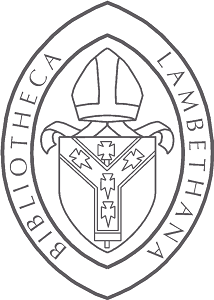When a book is bound, the main text block is surrounded by a few ‘endpapers’ that divide the body of the work from its cover. In modern books, these pages are almost always blank, and you may have flipped past them without really thinking about it. However, in works printed from the 15th to 18th centuries, it was common for the endpapers to contain part of a recycled text, either from a complete book which had been acquired by a binder’s shop to be dismantled, or printed sheets direct from a printshop that had been found to have errors. In the instance of whole volumes being recycled, binders frequently made use of medieval manuscripts that in some cases were already several hundred years old when they were cut apart. While chopping up these meticulously scribed and sometimes beautiful items may seem a shocking thing to do now, it is less surprising in the context of the decades following the Reformation and, at least in England, the dissolution of the monasteries and their monastic libraries.[1]




It appears, however, that the edition of the martyrology from which we have a fragment may have never been finished. Rather than a complete work making its way into circulation as a pocket reference book, these sheets were instead present in a binder’s workshop to be used to surround another text, in our case a commentary on the 116th psalm which was published the following year. The English Short Title Catalogue records just one other fragment of this particular edition, which like ours exists as an uncut sheet. The other listed fragment has only one sheet with signature “B”, whereas we have a sheet “C” as well. It is possible that there are other copies that have not been recorded; older cataloguing standards did not require the recording of manuscript and printed waste and so many examples of waste are still probably unrecorded, and even waste that has been recorded in library catalogues may not be identified. It is often difficult to do so: think about how you would identify a book by two of its middle pages, or just a portion of one arbitrary, possibly even unnumbered, page. Identification has become much more achievable since the advent of fully text searchable works online, but in many institutions, including Lambeth, the bulk of work on fragments has yet to be done. Who’s to say what other exciting discoveries are waiting inside the boards of our books?
References
Evenden, Elizabeth and Thomas Freeman. Religion and the Book in Early Modern England. Cambridge: Cambridge University Press, 2011.
Highley, Christopher and John N. King, eds. John Foxe and his World. Abingdon: Routledge, 2017.
King, John N. “Guides to Reading Foxe’s Book of Martyrs.” Huntington Library Quarterly, 68, no. 1-2 (2005): 133-150. Accessed 29 May, 2020. doi:10.1525/hlq.2005.68.1-2.133
McCann, Wesley. “Irish Booklore: An Unrecorded Belfast Edition of John Taylor’s “Verbum Sempiternum”.” The Linen Hall Review 6, no. 2 (1989): 14-15. Accessed May 29, 2020. www.jstor.org/stable/20534078
Metzger, Bruce M., and Michael D. Coogan, eds. The Oxford Companion to the Bible. Oxford: Oxford University Press, 1993.
Riain, Dagmar Ó. “Ireland’s Oldest Music Manuscript?” History Ireland 5, no. 3 (1997): 11-13. Accessed May 29, 2020. www.jstor.org/stable/27724478.
Sawyer, Daniel. “Rediscovered Manuscript Fragments of “The Prick Of Conscience” in the Library of Queens’ College, Cambridge.” Transactions of the Cambridge Bibliographical Society, 15, no. 4 (2015): 515-539. Accessed May 29, 2020. www.jstor.org/stable/24900125.
Smyth, Adam. “Printed Waste: ‘Tatters Allegoricall.’” In Material Texts in Early Modern England, 137-174. Cambridge: Cambridge University Press, 2018. doi:10.1017/9781108367868.005.
Thomson, R. M. “More Fragments Of Solinus in Cambridge Libraries.” Transactions of the Cambridge Bibliographical Society, 16, no. 1 (2016): 125-131. Accessed May 29, 2020. www.jstor.org/stable/26626350.
Voigts, Laura, and Frank Stubbings. “”Promptorium Parvulorum”: Manuscript Fragments at Emmanuel College and Their Relation to Pynson’s “Editio Princeps”.” Transactions of the Cambridge Bibliographical Society, 9, no. 4 (1989): 358-371. Accessed May 29, 2020. www.jstor.org/stable/41154666
[1] Adam Smyth, “Printed Waste: ‘Tatters Allegoricall.’” In Material Texts in Early Modern England (Cambridge: Cambridge University Press, 2018), 144-145, 153.
[2]Ibid., 148.
[3] R. M. Thomson, “More Fragments of Solinus in Cambridge Libraries.” Transactions of the Cambridge Bibliographical Society, 16, no. 1 (2016), 131; for instances of articles about manuscript discoveries see for example Sawyer, 2015; Riain, 1997; and Voigts & Stubbings, 1989.
[4] Wesley McCann, “Irish Booklore: An Unrecorded Belfast Edition of John Taylor’s “Verbum Sempiternum”.” The Linen Hall Review 6, no. 2 (1989), 14.
[5] Ibid., 14
[6] Bruce Metzger and Michael Coogan (eds) The Oxford Companion to the Bible (Oxford: Oxford University Press, 1993), 144)
[7] (see for example Evenden and Freeman, 2011; King, 2005; and Highley & King, 2017)
[8] John N. King, “Guides to Reading Foxe’s Book of Martyrs”. Huntington Library Quarterly, 68, no. 1-2 (2005), 148-149

